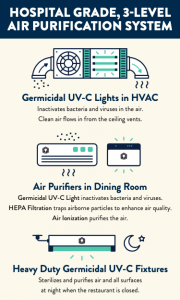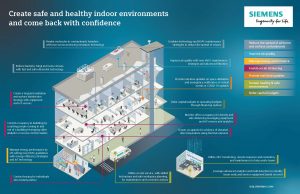Using Efficiency to Combat COVID-19: Technologies to Keep Us Safe
by Rebecca Hui, Office Manager at VAEEC
When business owners shut off the lights this spring, they had no idea that months later, the nation would still be in the throes of the COVID-19 pandemic. It’s no secret that this virus has irreversibly changed the world around us, and continues to do so with every new development. This three part series will focus on the ways VAEEC members are meeting these challenges head on to keep their customers and their communities safe.
So what does energy efficiency have to do with COVID-19? A surprising amount. Research shows that the buildings where people work, live, and play can dramatically affect their health. A 2019 study from VAEEC member, VEIC, stated that Americans spent nearly 70% of their time in their homes – and that was well before stay-at-home orders and social distancing went into effect. Poor insulation, leaky windows, aging appliances, and improper ventilation all contribute to many of the leading causes of death in the U.S.: asthma, heart disease, chronic respiratory illness, and stroke (ACEEE 2019). While energy efficiency measures have been helping to address many of these problems for years, the new, acute threat of COVID-19 has forced the industry to rapidly adapt to changing – and sometimes contradictory – needs.
New Challenges
While many things about COVID-19 remain unknown, data shows that one thing is clear – the virus spreads faster indoors, and as viral load and exposure time increase, so does the likelihood of infection. ACEEE recently stated that, of 1,500 known superspreader events, only three took place entirely outdoors. This reality has brought ventilation and indoor air quality into laser focus for many businesses and commercial and multi-family building owners as they scramble to meet the changing needs of their staff, customers, and residents.
“If we can take one good thing out of [the pandemic], it’s bringing a focus to the building environment and how healthy that building environment can be for occupants,” said Chris Rawlings, Chief Energy Officer of VeteranLED. In light of the pandemic, experts recommend increasing the number of air changes per hour in a building and running HVAC systems continuously to flush out potentially infectious air. Although outdoor air dilutes contaminants, increasing ventilation rates reduces the energy efficiency of the space, leading to a tricky balance between safety and rising energy costs. To solve this problem, many are looking toward technology.
VAEEC Board member George Barnes, Account Manager for Complex Solutions for Trane said, “the challenge is to complete [measures] in an energy efficient manner. If done correctly, spaces will be safer, occupants will be healthier, and any cost increases will be mitigated.”
New Ventures
Customers aren’t the only ones looking for ways to help keep their businesses afloat. The energy efficiency industry has been hit hard by the pandemic, causing many businesses to adapt to a new set of needs. For Rawlings, this meant a hard pivot into previously unknown territory – installing UVGI systems.
 Ultraviolet Germicidal Irradiation (UVGI) has been used for decades to help stop the spread of infectious diseases. It uses shortwave ultraviolet radiation, or UV-C, to damage the microbe’s DNA, which in the case of coronaviruses, causes the outer protein coating to break down and render the virus inactive. Because UV-C radiation is only effective when in direct contact with a pathogen, it has to be correctly implemented to combat COVID-19 and other diseases. There are two common strategies for using UVGI systems: integrating the fixtures into the HVAC system, and using “upper room” systems.
Ultraviolet Germicidal Irradiation (UVGI) has been used for decades to help stop the spread of infectious diseases. It uses shortwave ultraviolet radiation, or UV-C, to damage the microbe’s DNA, which in the case of coronaviruses, causes the outer protein coating to break down and render the virus inactive. Because UV-C radiation is only effective when in direct contact with a pathogen, it has to be correctly implemented to combat COVID-19 and other diseases. There are two common strategies for using UVGI systems: integrating the fixtures into the HVAC system, and using “upper room” systems.
In-Line Duct systems use UVGI lighting inside the ducts of a building, passing air through the radiation and rendering microbes incapable of replicating. These solutions also incorporate HEPA or other high-efficiency filtration systems to remove the contaminants from the air.
Meanwhile, “upper room” systems irradiate the air near the ceiling of a room, above the heads of any inhabitants, and use fans and circulators to move the air in the lower part of the room into the irradiation zone. While UV-C is less harmful to humans than other types of UV radiation, UVGI still must be carefully and correctly implemented to reduce exposure.
VeteranLED has been installing and designing energy efficient building systems since 2014, but incorporating UVGI technology was a completely new challenge. By “really diving into the research” and applying his experience, Rawlings developed an integrated air purification system that uses UVGI lighting in an in-line duct system and hospital grade UV-C fixtures that can sterilize surfaces when the space is not occupied.
“We’ve been able to tap into resources and networks where [health] has been a priority since the get-go, like hospitals and laboratories,” said Rawlings. VeteranLED was hired to install their air purification systems in 20 Silver Diner restaurants across the Midatlantic region.
New Directions
For other organizations, COVID-19 has meant doubling down on the technologies they already offer. Siemens has been a long time leading provider of Internet of Things (IoT) technologies. The question, for them, was how to adapt their existing portfolio to meet the changing needs of Siemens’ customers?
“As a company that diligently practices a ‘Zero Harm’ culture, we had to learn how to protect our employees and our customers while ensuring our communities most important infrastructure assets were operating and available to serve their mission,” said Michele Mitch-Peterson, Ingenuity Consultant for Siemens Smart Infrastructure team. Siemens provides an array of high-performance building systems, including occupancy and temperature sensors, energy performance management systems, and non-ozone producing ionization technology.
 Building automation systems, or BAS, is an automated, central control system that manages the HVAC, lighting, security, and other interrelated systems in a building. Automation systems use a variety of tools such as sensors and controls to improve comfort and reduce energy use and maintenance costs. These technologies have been advancing in both complexity and popularity since the early 2000’s, and have been adopted in most new commercial, industrial, and institutional construction. Siemens has been on the forefront of much of this innovation.
Building automation systems, or BAS, is an automated, central control system that manages the HVAC, lighting, security, and other interrelated systems in a building. Automation systems use a variety of tools such as sensors and controls to improve comfort and reduce energy use and maintenance costs. These technologies have been advancing in both complexity and popularity since the early 2000’s, and have been adopted in most new commercial, industrial, and institutional construction. Siemens has been on the forefront of much of this innovation.
“In the midst of all the uncertainty COVID-19 caused, we really sought to find projects and innovations to minimize the impact on our customers and give them certainty around energy savings, especially with buildings not being occupied,” said Peterson. Siemens was able to work with customers to implement specific energy reduction plans based on current usage. Using a variety of their proprietary solutions, they were able to automatically adjust systems due to reduced demand, continuously monitor buildings via Fault Detection and Diagnostics, and analyze sub-meter data to determine the effects of actions taken and identify areas where further energy savings could be achieved.
“It has been an extremely challenging period, but also extremely rewarding as we have found new ways to serve our customers.”
